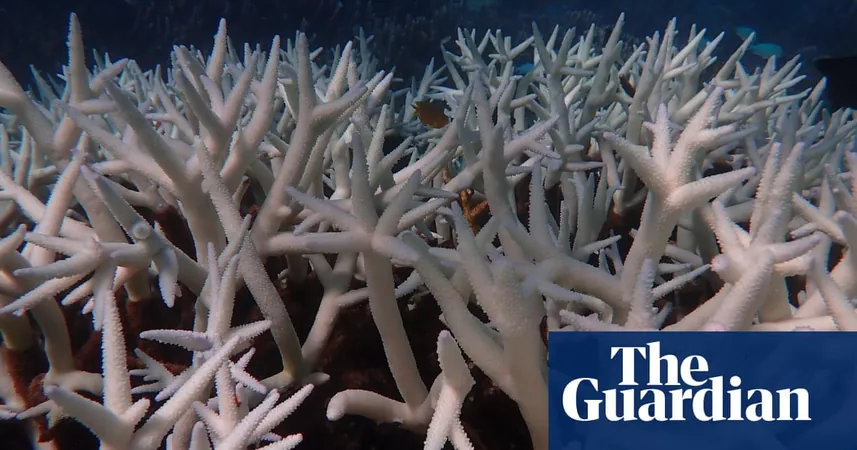
Double Trouble: Ningaloo and the Great Barrier Reef Face Alarming Coral Bleaching Crisis
2025-03-22
Author: Daniel
Introduction
Australia's renowned coral ecosystems, the Ningaloo Reef on the west coast and the Great Barrier Reef to the east, have both been struck by devastating coral bleaching events simultaneously, prompting experts to describe the situation as "heartbreaking" and "profoundly distressing." This unprecedented occurrence raises urgent concerns about the impacts of climate change on these vital marine environments.
Extent of Heat Stress
Scientists are actively assessing the extent of heat stress affecting thousands of kilometers of reef ecosystems. Reports indicate that the Great Barrier Reef is seeing widespread bleaching from Townsville to Cape York—a staggering 1,000-kilometer stretch. Meanwhile, Ningaloo Reef has recorded the highest levels of heat stress ever documented, exacerbated by an extended marine heatwave, threatening the future of its corals.
Historical Significance
“The current state of these two world-famous reefs will likely be noted in history as a critical moment of loss,” said Paul Gamblin, Chief Executive of the Australian Marine Conservation Society. In her recent fieldwork, Dr. Zoe Richards—a coral scientist from Curtin University—found alarming evidence of up to 90% coral bleaching in popular snorkeling spots. Even ancient corals, some hundreds of years old, are succumbing to this crisis. Just three years ago, Ningaloo experienced a significant bleaching event, but this latest episode seems even more widespread and severe.
Government and Scientific Response
The WA government is collaborating with scientists to monitor additional reefs under pressure, highlighting reports of bleaching at Kimberley, Ashmore Reef, Rowley Shoals, and various other locations. According to Dr. Richards, "The entire northwest shelf is experiencing these impacts. This scale is unprecedented. Climate change has caught up with our reefs, and it is more severe than ever."
Coral Bleaching Mechanism
Coral reefs rely on symbiotic algae for their vibrant colors and nutrient intake. When seawater temperatures rise too high, corals expel these algae, leading to a stress response known as bleaching. If conditions don't improve, bleached corals face a high risk of mortality and a reduced capacity for recovery and reproduction.
Monitoring Coral Health
Experts monitor coral health using a metric called Degree Heating Weeks (DHW), which indicates how much heat has accumulated in a specific area. Corals begin to bleach at about 4 DHW, and conditions reaching 8 DHW are often lethal to sensitive species. Unfortunately, areas around Ningaloo have recently been recorded at an alarming 16 DHW, pointing to an immediate threat to coral survival.
Aerial Monitoring of Great Barrier Reef
The Great Barrier Reef Marine Park Authority has been conducting aerial monitoring, revealing low to high levels of bleaching across most surveyed reefs. A staggering 24 out of 30 reefs surveyed showed signs of stress, primarily concentrated in northern areas, with no current concerns for the southern sections of the park.
Recent Trends in Bleaching Events
Last summer marked a record-breaking bleaching event for the Great Barrier Reef, which was already facing the fifth significant outbreak in just eight years. Experts like Dr. Neal Cantin observed that bleaching severity tends to increase closer to the shore, with hotspots showing DHW metrics capable of causing coral mortality.
Consequences on Lizard Island
Moreover, Dr. Emily Howells from Southern Cross University noted this year represents the sixth consecutive summer of coral bleaching witnessed at Lizard Island. The impacts here have been devastating—the island lost a third of its live coral last year due to extreme heat, and although coral mortality appears lower this year, it's primarily because the most vulnerable populations have already perished.
Additional Threats
With increasing threats from both heatwaves and severe flooding brought about by intense rainfall, the situation becomes even grimmer. Flood plumes have been observed extending 700 kilometers down Australia’s coastline, carrying sediments that affect light quality and stimulate excessive algae growth, further suffocating coral ecosystems.
Call for Action
Paul Gamblin emphasizes the urgent need for action, lamenting how fossil fuel companies continue to pursue environmentally damaging mega-projects that undermine the stability of these reefs. “What will future generations say when they look back at how we treated our oceans?” he urged.
Conclusion
The dual crises at Ningaloo and the Great Barrier Reef serve as a wake-up call about the pressing need for concerted action against climate change, urging policymakers, corporations, and individuals to heed the warnings and work towards a sustainable future for these irreplaceable natural wonders.

 Brasil (PT)
Brasil (PT)
 Canada (EN)
Canada (EN)
 Chile (ES)
Chile (ES)
 Česko (CS)
Česko (CS)
 대한민국 (KO)
대한민국 (KO)
 España (ES)
España (ES)
 France (FR)
France (FR)
 Hong Kong (EN)
Hong Kong (EN)
 Italia (IT)
Italia (IT)
 日本 (JA)
日本 (JA)
 Magyarország (HU)
Magyarország (HU)
 Norge (NO)
Norge (NO)
 Polska (PL)
Polska (PL)
 Schweiz (DE)
Schweiz (DE)
 Singapore (EN)
Singapore (EN)
 Sverige (SV)
Sverige (SV)
 Suomi (FI)
Suomi (FI)
 Türkiye (TR)
Türkiye (TR)
 الإمارات العربية المتحدة (AR)
الإمارات العربية المتحدة (AR)